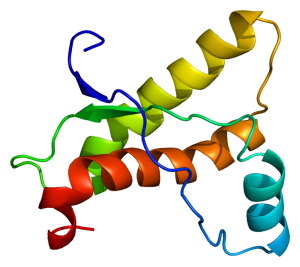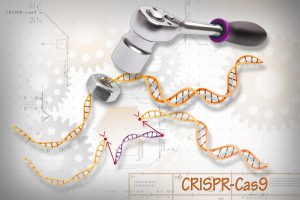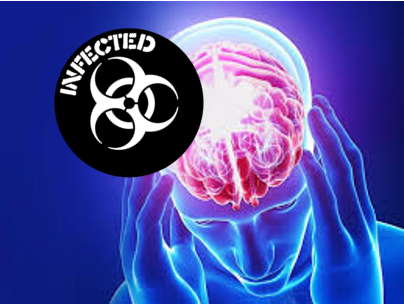[Editor’s Note: Mad Scientist Laboratory is pleased to publish today’s guest post by proclaimed Mad Scientists LtCol Jennifer Snow and Dr. James Giordano, and returning guest blogger Joseph DeFranco. Their post sounds a loud and clear klaxon for both the national defense and medical research establishments regarding the possible weaponization of prion diseases and the associated potential for sowing wide-spread fear across national populations, disrupting global markets, and generating enduring multi-domain, multi-dimensional adverse effects! As Geena Davis tells Jeff Goldblum in the 1986 horror classic, The Fly, “Be afraid, be very afraid…“]
“Why, anybody can have a brain… Every pusillanimous creature that crawls on the Earth or slinks through slimy seas has a brain…” — L. Frank Baum, The Wizard of Oz
 Recent concern about the spread of Chronic Wasting Disease (CWD) in cervids (i.e., deer, elk, and moose) has provoked media and public interest1 in whether this outbreak poses a risk to human public health. Referred to as the “zombie deer disease,” CWD is a prion disorder that spreads via bodily fluids or contaminated soil, food, or water. Prion diseases – or transmissible spongiform encephalopathies (TSEs) – are fatal neurodegenerative disorders that are caused by the misfolding and aggregation of normal prion proteins (PrPC) to then form the disease-causing isoform (PrPSc). In 2000, only five states reported populations of infected cervids. Today, three-quarters of the United States and Canada are reporting CWD outbreaks in cervid populations. While there are varying perspectives on the transmissibility of CWD from cervids to humans2 3, given the known characteristics of prions, scientists are duly worried about the potential for cross species infection.4
Recent concern about the spread of Chronic Wasting Disease (CWD) in cervids (i.e., deer, elk, and moose) has provoked media and public interest1 in whether this outbreak poses a risk to human public health. Referred to as the “zombie deer disease,” CWD is a prion disorder that spreads via bodily fluids or contaminated soil, food, or water. Prion diseases – or transmissible spongiform encephalopathies (TSEs) – are fatal neurodegenerative disorders that are caused by the misfolding and aggregation of normal prion proteins (PrPC) to then form the disease-causing isoform (PrPSc). In 2000, only five states reported populations of infected cervids. Today, three-quarters of the United States and Canada are reporting CWD outbreaks in cervid populations. While there are varying perspectives on the transmissibility of CWD from cervids to humans2 3, given the known characteristics of prions, scientists are duly worried about the potential for cross species infection.4

CWD is not the only TSE to present a potential public health crisis. Bovine spongiform encephalopathy (BSE), or “mad cow disease,” is a well-known threat that had a devastating impact on global cattle populations, the associated agricultural-industrial complex, and the economy. BSE is highly virulent and is spread interspecies  through contaminated feed and biological fluids (e.g., saliva, urine, etc.). Following the first case of mad cow disease in the United States in 2003,5 the high level of media attention resulted in a 20% drop in global beef sales and long-term negative impacts to the beef industry worldwide.
through contaminated feed and biological fluids (e.g., saliva, urine, etc.). Following the first case of mad cow disease in the United States in 2003,5 the high level of media attention resulted in a 20% drop in global beef sales and long-term negative impacts to the beef industry worldwide.
In humans, Creutzfeldt-Jakob disease (CJD) is the zoonotically-transmitted pathology that can be contracted from consuming BSE-contaminated meat.6 CJD presents as an escalating constellation of neurological and psychiatric symptoms, including dementia, muscle spasms, and blindness. Additionally, individuals diagnosed with CJD often experience secondary opportunistic infections, which can advance their mortality. To date, methods for the detection and decontamination of prions remain inadequate, if not downright hazardous (i.e., if these protocols are stringently followed, the result is a “salted earth” situation wherein the treated area becomes devoid of all life). As there are no known cures or treatments for prion diseases, any and all prion contaminations resulting in TSE are fatal. While recent research efforts have helped to gain deeper understanding of various manifestations and possible treatment options that have been important to awareness of public health concerns relevant to TSEs, prion diseases remain a zoonotic threat.

One threat domain is the growing viability of developing and employing prions as biological weapons. Bioweaponizable agents are controlled by U.S. federal and international regulations (e.g., Select Agents and Toxins List7), and research using these agents requires specific authorization and safety controls (i.e., biosecurity level classification of the engaged laboratory8). However, because TSEs are regarded as neurodegenerative disorders, they are often handled in ways accordant to similar types of disease (e.g., Alzheimer’s and/or Parkinson’s disease).  Thus, to date, prion research has mostly been conducted in general laboratory spaces that are not under federal or international surveillance or bioweapon reporting standards and dictates. However, ongoing developments in prion research suggest – and we argue, support – that such efforts should be regarded as dual use research of concern (DURC), with accordingly appropriate regulation.
Thus, to date, prion research has mostly been conducted in general laboratory spaces that are not under federal or international surveillance or bioweapon reporting standards and dictates. However, ongoing developments in prion research suggest – and we argue, support – that such efforts should be regarded as dual use research of concern (DURC), with accordingly appropriate regulation.
Recent advances in prion-disease modelling have enabled production of synthetic prions (PrPSc) which can be engineered in vitro (i.e., the lab), and have been demonstrated to produce TSE-like symptoms in vivo (i.e., in living organisms).9 10 Additionally, various methods to optimize the amount of PrPSc generated from a single sample have been described.11 While these methods and assays require a certain level of expertise, the production of synthetic disease-causing prions has been successfully replicated in a number of research facilities worldwide.
 Prion diseases characteristically have a long incubation period before manifesting signs and symptoms in the host organism. Therefore, to facilitate prion research, efforts have been taken to shorten this latency period, thereby allowing prions to become active and present signs and symptoms in a matter of weeks instead of years.12 From a dual use perspective, this may be of value and use to nefarious actors who wish to produce TSE in targeted organisms in a shorter period of time. Other studies have demonstrated that aerosolized prion-containing brain homogenates can produce TSEs.13 14 Following exposure to prion particles, test subjects (i.e., mice and deer) became symptomatic and succumbed to the prion infection.
Prion diseases characteristically have a long incubation period before manifesting signs and symptoms in the host organism. Therefore, to facilitate prion research, efforts have been taken to shorten this latency period, thereby allowing prions to become active and present signs and symptoms in a matter of weeks instead of years.12 From a dual use perspective, this may be of value and use to nefarious actors who wish to produce TSE in targeted organisms in a shorter period of time. Other studies have demonstrated that aerosolized prion-containing brain homogenates can produce TSEs.13 14 Following exposure to prion particles, test subjects (i.e., mice and deer) became symptomatic and succumbed to the prion infection.
Further, research has demonstrated the ability of prion proteins to influence and promote other pathogens with high morbidity and mortality (e.g., influenza A, and/or human immunodeficiency virus type-1).15 16 Moreover, there have been successful efforts in the cross-species transmission of prion diseases: In 2014, studies demonstrated squirrel monkeys’ susceptibility to (cervid) CWD.17
F inally, although not of least concern, advancements in genomics and proteomics have made it possible for CRISPR/Cas9 and other gene editing systems to be used to modify – or foster novel – prions.18 To be sure, gene editing may allow means to gain further insight into molecular mechanisms of prion development and transmission. But such insights and capabilities could also be used to dispose or induce greater vulnerability in both animal species, and for zoonotic transmission. To this latter point, gene editing may provide vectors to alter prion expression. For example, recently demonstrated success in adding a human gene to a non-human primate to generate enhanced short-term memory affords possibilities to modify neural substrates to generate unique and potentially dangerous characteristics and effects.19
inally, although not of least concern, advancements in genomics and proteomics have made it possible for CRISPR/Cas9 and other gene editing systems to be used to modify – or foster novel – prions.18 To be sure, gene editing may allow means to gain further insight into molecular mechanisms of prion development and transmission. But such insights and capabilities could also be used to dispose or induce greater vulnerability in both animal species, and for zoonotic transmission. To this latter point, gene editing may provide vectors to alter prion expression. For example, recently demonstrated success in adding a human gene to a non-human primate to generate enhanced short-term memory affords possibilities to modify neural substrates to generate unique and potentially dangerous characteristics and effects.19
In sum, current knowledge, tools, and methods may allow the leveraging of prion research in bioweapon programs to: (1) enable synergistic effects with other pathogens to produce a “precision” effect; and/or (2) engineer a novel prion-based agent using gene editing or associated technologies. We opine that the threat of using prions in non-kinetic engagements must also be considered.
For instance, a scenario in which prion-based agents were used to impact targeted markets or widespread animal resources could prompt public fears and serve to disrupt specific regional or global markets to incur disruptive effect(s) in international or inter-industrial competition or adversarial engagement.  The effecting actor could then offer viable alternative products or treatments to capitalize on the disruption, thereby establishing relative economic hegemony – and power – in both these markets, and perhaps on the world stage. If and when combined with a well-executed misinformation campaign, such an approach could yield multi-domain, multi-dimensional effects (e.g., in agri-markets, public health, safety and security, economic stability, and geo-political power) that would be iterative, robust, and likely evoke durable consequences.
The effecting actor could then offer viable alternative products or treatments to capitalize on the disruption, thereby establishing relative economic hegemony – and power – in both these markets, and perhaps on the world stage. If and when combined with a well-executed misinformation campaign, such an approach could yield multi-domain, multi-dimensional effects (e.g., in agri-markets, public health, safety and security, economic stability, and geo-political power) that would be iterative, robust, and likely evoke durable consequences.
Thus, as prion research advances as a result of the use of radical leveling and emerging technologies and techniques, the risks posed by weakly or un-surveilled, and unregulated efforts in this space will also increase. In this light, we advocate the imperative to focus more closely on current capabilities and developments in prion research that could be employed in dual- and/or direct use as a bioweapon in both kinetic and non-kinetic engagements.
If you found this post of interest, please also see:
- Dr. Giordano‘s presentations:
– Neurotechnology in National Security and Defense, from the Mad Scientist Visioning Multi Domain Battle in 2030-2050 Conference at Georgetown University in Washington, DC, on 25 & 26 July 2017.
– Neuroscience and the Weapons of War podcast, with Mr. John Amble, hosted by our colleagues at Modern War Institute (MWI), 2 August 2017.
- Fellow Mad Scientist Max Brooks‘ Germ Warfare: A Very Graphic History.
- Our Battle of the Brain blog post.
- Our Bio Convergence and Soldier 2050 Conference Final Report, discussing the democratization of genome editing technology, enabling non-state actors to weaponize bio-technology.
Joseph DeFranco is J5 Donovan Group Fellow in Biowarfare and Biosecurity, at U.S. Special Operations Command (USSOCOM). He is currently studying neuroscience in the College of Arts and Sciences, and biodefense at the Schar School of Policy and Government of George Mason University, VA, and formerly served on the staff of Congressman Donald S. Beyer (VA-08). His current research focuses upon the possible use of novel microbiological agents and big data as force-multiplying elements in non-kinetic, hybrid, and kinetic engagements, and the role of global agencies in biosecurity.
Mad Scientist LtCol Jennifer “JJ” Snow, USAF, is the Donovan Group Innovation Officer for the U.S. Special Operations Command (USSOCOM), J52 Futures Plans and Strategy Division and SOFWERX Team. She serves as the military representative for technology outreach and engagement to bridge the gap between government and various technology communities to improve collaboration and communications, identify smart solutions to wicked problems and help guide the development of future smart technology policy to benefit special operations.
Mad Scientist James Giordano, PhD, is Professor of Neurology and Biochemistry, Chief of the Neuroethics Studies Program, and Co-Director of the O’Neill-Pellegrino Program in Brain Science and Global Law and Policy at Georgetown University Medical Center. He currently serves as J5 Donovan Group Senior Fellow, Biowarfare and Biosecurity, U.S. Special Operations Command (USSOCOM), and as an appointed member of the Neuroethics, Legal, and Social Issues (NELSI) Advisory Panel of the Defense Advanced Research Projects Agency (DARPA). Previously, Dr. Giordano served as Senior Science Advisory Fellow of the Strategic Multilayer Assessment Group of the Joint Staff of the Pentagon; and was Senior Research Fellow and Task Leader for the EU Human Brain Project Subproject on Dual Use Brain Science.
Disclaimer: The views expressed in this blog are those of the authors, and do not necessarily reflect those of the Department of Defense, US Army, US Air Force, US Special Operations Command, or the Defense Advanced Research Projects Agency (DARPA).
Acknowledgments: This blog was adapted from the authors’ whitepaper for the Strategic Multilayer Assessment Group, Joint Staff, Pentagon, and paper in the Journal of Defense Life Sciences.
References:
1 For more information and news stories on the Chronic Wasting Disease, please see: https://www.cdc.gov/prions/cwd/occurrence.html ; http://time.com/5532416/what-is-zombie-deer-disease/ ; https://www.usatoday.com/story/news/nation/2019/02/19/zombie-deer-disease-why-deer-cwd-nothing-like-zombies/2906715002/ ; https://www.cbsnews.com/news/is-zombie-deer-disease-a-threat-to-humans/
2 Waddell, L., Greig, J., Mascarenhas, M., Otten, A., Corrin, T., & Hierlihy, K. (2018). Current evidence on the transmissibility of chronic wasting disease prions to humans—a systematic review. Transboundary and Emerging Diseases, 65(1), 37-49.
3 Race, B., Meade-White, K. D., Phillips, K., Striebel, J., Race, R., & Chesebro, B. (2014). Chronic wasting disease agents in nonhuman primates. Emerging Infectious Diseases, 20(5), 833.
4 Barria, M. A., Libori, A., Mitchell, G., & Head, M. W. (2018). Susceptibility of human prion protein to conversion by chronic wasting disease prions. Emerging Infectious Diseases, 24(8), 1482.
5 Schlenker, W., & Villas-Boas, S. B. (2009). Consumer and market responses to mad cow disease. American Journal of Agricultural Economics, 91(4), 1140-1152.
6 For more information on Creutzfeldt-Jakob disease (CJD) please see:
https://www.cdc.gov/prions/cjd/index.html
7 For the HHS and USDA Select Agents and Toxins List, please see: https://www.selectagents.gov/selectagentsandtoxinslist.html
8 For more information on biosafety levels and laboratories, please see: https://www.niaid.nih.gov/research/biodefense-biosafety-labs
9 Burke, C., Walsh, D., Steele, A., Agrimi, U., Di Bari, M. A., Watts, J. C., & Supattapone, S. (2019). Full restoration of specific infectivity and strain properties from pure mammalian prion protein. PLoS Pathogens, 15(3), e1007662.
10 Bistaffa, E., Moda, F., Virgilio, T., Campagnani, I., De Luca, C. M. G., Rossi, M., Salzano, G., Giaccone, G., Tagliavini, F. & Legname, G. (2018). Synthetic Prion Selection and Adaptation. Molecular Neurobiology, 1-12.
11 Hwang, H. G., Kim, D. H., Lee, J., Mo, Y., Lee, S. H., Lee, Y., Hyeon, J. W., Lee, S. M., Cheon, Y., Choi, E., Kim, S. Y., Kim, S. Y., Son, Y. & Ryou, C. (2018). High-Level Production of High-Purity Human and Murine Recombinant Prion Proteins Functionally Compatible to In Vitro Seeding Assay. Journal of Microbiology and Biotechnology, 28(10), 1749-1759.
12 Thackray, A. M., McKenzie, A. N., Klein, M. A., Lauder, A., & Bujdoso, R. (2004). Accelerated prion disease in the absence of interleukin-10. Journal of Virology, 78(24), 13697-13707.
13 Denkers, N. D., Hayes-Klug, J., Anderson, K. R., Seelig, D. M., Haley, N. J., Dahmes, S. J., Osborn, D. A., Miller, K. V., Warren, R. J., Mathiason, C. K. & Hoover, E. A. (2013). Aerosol transmission of chronic wasting disease in white-tailed deer. Journal of Virology, 87(3), 1890-1892.
14 Haybaeck, J., Heikenwalder, M., Klevenz, B., Schwarz, P., Margalith, I., Bridel, C., Mertz, K., Zirdum, E., Petsch, B., Fuchs, T. J., Stitz, L. & Aguzzi, A. (2011). Aerosols transmit prions to immunocompetent and immunodeficient mice. PLoS Pathogens, 7(1), e1001257.
15 Chida, J., Hara, H., Yano, M., Uchiyama, K., Das, N. R., Takahashi, E., Miyata, H., Tomioka, Y., Ito, T., Kido, H. & Sakaguchi, S. (2018). Prion protein protects mice from lethal infection with influenza A viruses. PLoS Pathogens, 14(5), e1007049.
16 Bacot, S. M., Feldman, G. M., Yamada, K. M., & Dhawan, S. (2015). Pathogenic prion protein fragment (PrP106–126) promotes human immunodeficiency virus type-1 infection in peripheral blood monocyte-derived macrophages. Virology, 476, 372-376.
17 Ibid. ref. 3.
18 For more information on prion studies utilizing CRISPR/Cas9, please see:
Mehrabian, M., Brethour, D., MacIsaac, S., Kim, J. K., Gunawardana, C. G., Wang, H., & Schmitt-Ulms, G. (2014). CRISPR-Cas9-based knockout of the prion protein and its effect on the proteome. PLoS One, 9(12), e114594; Kaczmarczyk, L., Mende, Y., Zevnik, B., & Jackson, W. S. (2016). Manipulating the prion protein gene sequence and expression levels with CRISPR/Cas9. PloS One, 11(4), e0154604; and https://minerva-access.unimelb.edu.au/handle/11343/212070
19 Shi, L., Luo, X., Jiang, J., Chen, Y., Liu, C., Hu, T., Li, M., Lin, Q., Li, Y., Huang, J., Wang, H., Niu, Y., Shi, Y., Styner, M., Wang, J., Lu, Y., Sun, X., Yu, H., Ji, W., & Su, B. (2019). Transgenic rhesus monkeys carrying the human MCPH1 gene copies show human-like neoteny of brain development. National Science Review.



